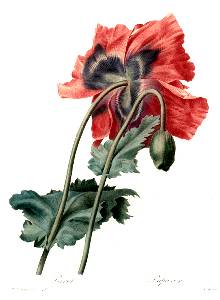
Coquelicot
Coquelicot is the French name for the regular corn or field poppies (Papaver rhoeas) so poppy red it is. As today in Regency times, Paris was the fashion capital of the civilized world and French fashions the epitome of chic, so French names abounded in all matters of apparel. Coquelicot was at the height of fashion in 1794-99 a. but was used continuously throughout the period. Coquelicot was such a bold color that for well brought up [young] ladies it was only permissible for trimmings or accessories. 1.
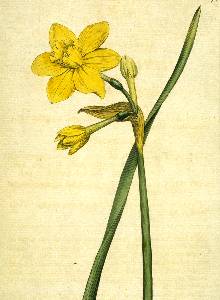
Jonquil
The jonquil (Narcissus jonquilla) is the small scented daffodil that grows wild in southern Europe. This plant has a more than 300 year long history of cultivation and was used in early times to hybridize our modern daffodil, thus jonquil is daffodil yellow, a true yellow color. Jonquil was The color of the 1801 b. season as jonquil was everywhere. The fashion magazines of the time mention ribbons, hats, draperies (scarfs and dress details NOT curtains!) and other trimmings in jonquil. No lady aspiring to be fashionable could do without it. 2.
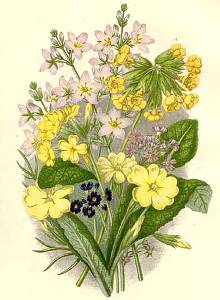
Primrose
Primrose is one of the colors that most confuse readers of Regency romances. Is it a bright yellow as some say or more of a soft yellow as some others seem to think? That depends on what primrose we are talking about. Regency fashion comes in two primrose colors, both inspired by flowers. First we have the soft, pale yellow of the common primrose, Primula vulgaris. It has a pleasing, mild yellow color suitable for daywear. 3.

Evening Primrose
The biennial Evening Primrose (Cenothera biennis) has a much deeper and brighter yellow color. When gloves and boots are described to be of primrose color it is this darker, deeper yellow the writer had in mind. Both the primrose colors were popular during the whole Regency period, and the height of fashion 1807-1817. c. So there we have the reason for the confusion: Two colors referred to with one name! 4.
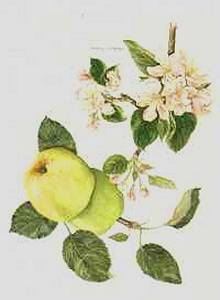
Pomona Green
Regency style is classic, based on old Greece and its buildings, thus classic allusions were not uncommon. Pomona was the Greek goddess of the orchards and the apple her favorite fruit. So what the Regency people called pomona green is simply apple green, a green color with a good helping of yellow in it. Green was a fashionable color both in clothes and furnishings during the Regency and pomona green apparel depicted in the periodicals of the day from 1812 d. to the end of the period. Pomona green was used both for trimming and whole dresses. 5.
The pigment used was Oxide Green Chrome or a decoction of galls and muriate of tin, depending on purpose. It is sometimes also referred to as nascent-green or iodine green. e.
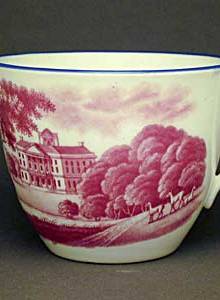
Puce
One of the more obscure colors used in Regency novels is puce. It's a color nearly always treated with disdain but what color was it, really? It might help to know that the word puce comes, as so many others, from the French. Puce is the French word for flea! Yes, the color is a brownish-purple or a purplish-pink, the color of the blood-sucking flea; coagulated blood in other words. It may seem astonishing to the modern reader that one of the most popular colors in 1805 f. was just puce! 6.

A Light Puce 7. also existed, which appears to have been a somewhat muted mauve. True mauve, as we know it, came with the Victorian aniline dyes. This dye was extremely unstable, faded badly to a dingy greyish pink. The German chemist Pörnerg. is the first to refer to a color as mauve or mallow. He used considerable amounts of alun to permanent the color, with somewhat depressing results. h.
The 1830s saw the introduction of a new recipe made from indigo and logwood (Haematoxylum campechianum), the later a native to North America. This was used both for puce and mauve but in different proportions, hence 'light puce' probably being the Regency word for a 'mauve' color. Wood contains natural tannins so a wood chip based dye would've been less prone to fading.

Emerald Green
1817 i. was the year emerald green burst upon the fashion scene in a big way. The pigment - alternately called Paris green, Sheele's green, Schweinfurth green, imperial green, Vienna green or emerald green - was already popular in interior decoration, particularly on wallpapers 8. and fabric. For the first time a green dye that did not fade or darken was available and it became all the rage. Unfortunately, the basis of this lovely bluish green was a copper arsenic compound! Yes, the pigment was poisonous, but this had yet to be discovered. j.
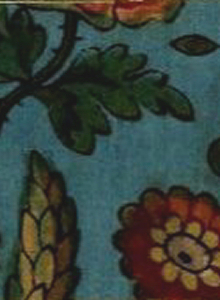
Cerulean Blue
Although blue shades referred to as Cerulean have existed for centuries and were not exactly inpopular in Regency times, k. the intense sky blue of today is a product of the Victorian era. During the Regency, the cerulean pigment was usually made up of a copper and cobalt mix, which had an unfortunate tendency to shift towards green. It was also a very unstable color that washed out badly. Not that the later was unusual for the times as colorfast dyes finally came into their own in the later part of the 19th century. 9
Note: Before the introduction of synthetic dyes, fading was a real problem. Knowing how to make a dye bath to refresh the color of otherwise still wearable garments was part and parcel of a good housewife's repertoire. It also explains (besides the issue of washing) why rich ladies rarely used the same dress twice during the season. The brilliance of the color would've been quite diminished after washing and/or exposure to the sun.